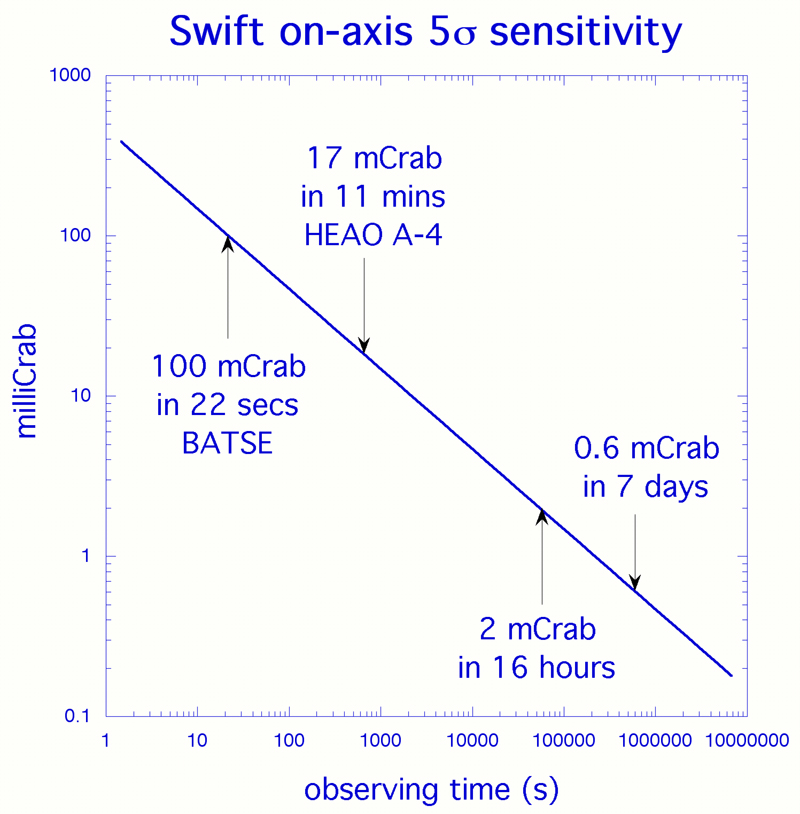Additional Swift Science
The BAT HArd X-Ray Survey
During Swift's first five years of operation BAT produced the most sensitive hard X-ray survey to date based on serendipitous GRB pointings. This survey has found over 1000 sources including more than 400 active galactic nuclei (AGN) and several elusive absorbed Seyfert 2 galaxies. The current BAT AGN catalog reaches a flux level of 1.4 x 10-11 erg cm2 s-1 (0.6 mCrab) in the 14-195 keV band and includes a complete sample of ∼600 AGN in the local Universe (median z = 0.04). In this energy range, such deep exposures are systematics limited. Although 2D coded apertures generally have better systematics than the alternatives (modulation collimators, fourier grids, &c.), we estimate the BAT detection sensitivity to be limited by systematic effects at ∼1 mCrab at high Galactic latitude (bII >45°) and ∼3 mCrabs when strong Galactic sources are in the field of view. These levels correspond to 20σ-70σ detections in a statistical sense. We are approximately 17 times more sensitive than the best complete hard X-ray survey (HEAO A-4, Levine et al. 1984, which is complete to 17 mCrab) for 1/3 of the sky and six times more sensitive for the rest. The scientific payoff from such a survey is be tremendous, and it is clearly endorsed for the study of black holes in the NRC Thaddeus report (1997).
Multi-wavelength Studies of AGN
Recent studies with ASCA, Ginga and BeppoSAX have shown the existence of a large population of highly absorbed Seyfert 2 galaxies with line-of-sight column densities > 1023 cm-2. The large column makes the nuclei of these objects essentially invisible at optical and soft X-ray wavelengths. Detailed models (Madau et al. 1994, Hasinger & Zamora 1997) show such a population of highly-absorbed AGN is needed to produce the observed 30 keV bump in the hard X-ray background, and that these AGN comprises ∼half of all AGN. The only known method of detecting such objects is an unbiased sky survey in the E > 10 keV band using an instrument with sufficient sensitivity to detect a large population of AGN.
The number of AGN observed at > 1 mCrab in the 2-10 keV range is ∼100 (Piccinotti et al. 1982), but AGN spectra are harder than the Crab, so this corresponds to 200-300 sources at >1 mCrab in the 10-100 keV band. The factor for highly absorbed AGN raises this total to 400-600 sources. These estimates are consistent with scaling from the six AGN in the HEAO A-4 survey. After five years Swift has found more than 400 AGN brighter than 1 mCrab.
Soft Gamma Repeaters
BAT is designed to discover rare phenomena from unpredictable parts of the sky. Soft gamma repeaters (SGRs) are such objects. BAT is sensitive to them because of its excellent short-burst trigger. While the SGR bursts are shorter than the Swift slew time, the XRT and UVOT perform sensitive searches immediately after a burst to identify the X-ray and optical counterparts. Continued monitoring makes it likely that Swift will be on on-target when subsequent bursts occur.
Supernovae
Swift has observed >100 supernovae (SNe) in the ultraviolet and X-ray bands, more than all other space-based observatories combined. Rapid tunaround observations can characterize SNe shortly after shock breakout. UVOT observations taken within four days of the explosion revealed the adiabatic cooling phase of the type IIb supernova SN2008ax (Roming et al. 2009). Swift has produced the first sample of thermonuclear SNe Ia that is large enough to allow the study of the absolute ultraviolet magnitude of these superenough to study the relationship between the peak ultraviolet luminosity and the decline in luminosity: a relationship that is critical for using supernova as cosmological yardsticks. Ultraviolet data also provides constraints on models of supernova progenitors and explosion physics.Rapid Reaction Science
The rapid reaction capability of the Swift observatory, using the TDRSS uplink, provides a unique ability to respond in a matter of minutes with sensitive gamma-ray, X-ray, ultraviolet, and optical observations to most events on the sky. This includes targets of opportunity for X-ray transients, pulsar glitches, outbursts from dwarf novae and stellar flares. The highly variable black-hole binary GX 339-4 is a good example of the importance of rapid multiwavelength observations for understanding accretion physics (Smith, Filippenko, & Leonard 1998). The BAT is >10 times more sensitive as a monitor than BATSE and initiates many targets of opportunity. Triggers from external sources can also be uploaded on time scales as short as four hours. Never before has there been a facility that can provide such rapid multiwavelength follow up to unpredictable events. As with any new observational capability, the potential for serendipitous science return is high.



